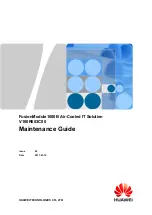
API Command Reference
Appendix A
A-16
NetScan User’s Manual
A
- Assign Alarm Output
TYPE
System
EXECUTION
Deferred
SYNTAX
Achans,
output
Set alarm condition where
chans
is the channel(s) to assign to the digital
output.
chans
may be in two forms:
chan
(for a single channel where
1
<
chan
< max) or
first-last
(for a range of channels where
1
<
first
<
last
<
max
), where max = 128 for NetScan.
output
is the digital output number with which to associate the channel(s),
where
0
<
output
<
32
.
A?
Query channels assigned to digital output.
DESCRIPTION
The Assign Alarm Output (
A
) command may be used to assign a particular channel, or range of channels, alarm
condition(s) to a particular digital output. This command allows internal alarm conditions to be sensed by
external devices via the 32 TTL-level digital outputs located on the back panel of the unit.
To use alarms, the channels in question must be part of the channel scan. Once the channels are configured (by
using the
C
command) and made part of the scan, the alarms are active. No trigger or timebase assignment is
required. Alarming is totally independent of buffered operations.
If it is desired, an alarm event for a specific channel can be used as a stimulus for a digital output signal on the
back panel of the unit by using the
A
command to assign the channel to digital output. This signal can be used
to set off an audible alarm or signal another device of the occurrence of the alarm condition.
To unassign a digital alarm condition, use
0
, which is the null output number. Assigning the null output number
to a channel(s) will disassociate the channel(s) from any digital output.
Thirty-two digital signals are available on the back panel of the master unit. Although analog input channels on
the slave units can be used to stimulate alarms, no digital output signals are available on the slave units.
Regardless of the number of slaves connected, 32 external alarm signals are available.
A channel programmed with alarm setpoints will not generate an alarm unless it is over a setpoint when the scan
occurs. For example, if a channel goes above then below an alarm threshold in-between scans, it will not be
detected or posted.
Alarm detection will generate an SRQ. You can then issue an alarm query (
A?
) which will return a 4-byte image
of the 32 alarm outputs.
EXAMPLE
PRINT#1,"C1-32, 1, -100.0,
100.0, 1.0X"
‘ Configure channels 1 - 32
PRINT#1,"A1,1X"
‘ Assign channel 1 alarm to digital output channel 1
PRINT#1,"A2-16,2X"
‘ Assign channels 2 - 16 alarms to digital output channel 2
PRINT#1,"A17-25,3X"
‘ Assign channels 17 - 25 alarms to digital output channel 3
PRINT#1,"A26-32,32X"
‘ Assign channels 26 - 32 alarms to digital output channel 32
Содержание OMB-NETSCAN 1500
Страница 6: ...iv NetScan User s Manual...
Страница 18: ...1 12 Configuring and Starting NetScan NetScan User s Manual Notes...
Страница 38: ...3 8 General Information and Specifications NetScan User s Manual Notes...
Страница 82: ...4 44 ChartView Software Reference NetScan User s Manual Notes...
Страница 111: ...NetScan User s Manual Calibration 6 13 1 Connect an applicable calibration harness to each card Refer to figure below...
Страница 118: ...6 20 Calibration NetScan User s Manual...
Страница 140: ...A ii NetScan User s Manual...
Страница 192: ...API Command Reference Appendix A A 52 NetScan User s Manual Notes...
Страница 237: ...Appendix D Registers Data Formats Queries NetScan User s Manual D 13...
Страница 244: ...NetScan Program Examples Appendix E E 2 NetScan User s Manual...
Страница 248: ...ASCII Code Summary Appendix F F 4 NetScan User s Manual Notes...
Страница 250: ...NetScan Error Messages Appendix G G 2 NetScan User s Manual Notes...
Страница 252: ...Abbreviations Appendix H H 2 NetScan User s Manual Notes...
Страница 254: ...NetScan User s Manual...
















































